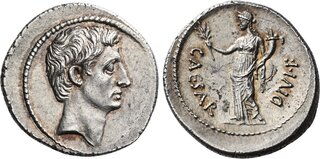| Numismatica Ars Classica > Auction 143 | Auction date: 7 May 2024 |
| Lot number: 461 Price realized: This lot is for sale in an upcoming auction - Bid on this lot  | Show similar lots on CoinArchives Find similar lots in upcoming auctions on |
| Lot description: The Dioscuri Collection. The Roman Empire. Octavian 32 – 27 and as Augustus, 27 BC – 14 AD. Brundisium and Roma Denarius 32-29 BC, AR 20 mm, 3.91 g. Bare head r. Rev. CAESAR – DIVI·F Pax, draped, standing l., holding olive branch and cornucopiae. C 69. BMC 605. RIC 252. Sear Imperators 399. CBN 27. Very rare and possibly the finest specimen known. An absolutely spectacular portrait in the finest style of the period. Lovely light iridescent tone, virtually as struck and almost Fdc Ex NAC 23, 2002, 1448 and NAC 94, 2016, 38 sales. Privately purchased from Freeman and Sear. This denarius was struck in the years of uncertainty between Octavian's defeat of Mark Antony and Cleopatra at the battle of Actium (31 BC), which made him sole master of the Roman Empire, and 27 BC, when he assumed the title and broad constitutional powers of Augustus, thereby becoming the first Roman Emperor. This was a dangerous period for both Octavian and Rome. Although his sheer military power made him the unquestionable ruler, to avoid the outbreak of a new round of civil wars, Octavian needed to carefully avoid the appearance of monarchy. To this end, he courted the Senate and public opinion to incrementally increase his authority through constitutional means. Despite his immense power, the obverse type seems to cast Octavian as just another magistrate of the Roman Republic. The portrait eschews any kind of ornamentation and there is no sign of the victor's laurel wreath or other headgear. Instead, he appears modestly bare headed as was generally expected of a respectable Roman citizen. The reverse type, however, provides the reason why both the Senate and People of Rome should honour the man portrayed on the obverse: through his victory at Actium he had allowed Pax, the Roman personification of Peace, to return after long years of ruinous civil war. Indeed, in 29 BC, he made a great show of the return of peace by personally closing the doors of the Temple of Janus. The short and simple message of this coin that must have been easily digestible by any Roman was that Octavian was a peace-bringer. That the message was clearly understood and accepted is indicated by the fact that when Octavian assumed full power as Augustus in 27 BC, the Senate awarded him the corona civica in recognition that he had saved the whole Roman people from civil war. However, at the same time the types of this denarius work to mould the public perception of Octavian in a post-civil war world, the old propaganda of the civil wars still lingers on in the legend, which names the issuer as Caesar, son of the god (i.e., Divus Julius). Estimate: 25000 CHF |  |



